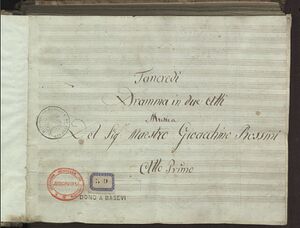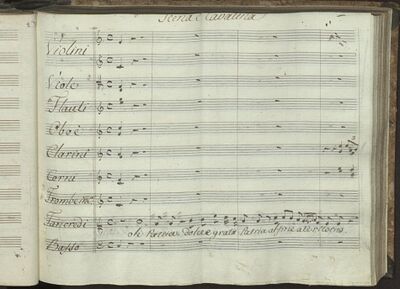Di tanti palpiti
{{Short description|aria from the opera Tancredi}}
| Tancredi | |
|---|---|
| Opera seria by Gioachino Rossini | |
 Cover of "Tancredi" | |
| Librettist | Gaetano Rossi |
| Language | Italian |
| Based on | Tancrède by Voltaire |
| Premiere | 6 February 1813 Teatro La Fenice, Venice |
The upbeat '"Di tanti palpiti" is sung by the main character in Gioacchino Rossini's opera Tancredi. The story of secred love thwarted by politics of the day in times of war is following the plot of Voltarire's Tancrède.
The plot is set in Sicily, 1005 A. D.. Tancredi has just returned to Syracuse in disguise. He is determined to risk his life for Amenaìde and longs to see her again.[1]
In the premiere cast, the part of Tancredi was sung by Adelaide Melanotte-Montresor.[1]
The piece was instantly popular and inspired many other musicians. Niccolo Paganini picked up the tune in his Variations on 'I palpiti', Op.13.[2]

"Di tanti palpiti" appears on the following album:
| Year | Album | With |
|---|
| Year | Album | |
|---|---|---|
| 2021 | À sa guitare (Album) | Thibaut Garcia |
It is part of the following concert programs:
| Year | Concert Program | With |
|---|---|---|
| 2021-2022 | À sa guitare (Concert program) | Thibaut Garcia |
| 2021 | Jean-Christophe Spinosi and Philippe Jaroussky with the Berliner Philharmoniker[3] | Jean-Christophe Spinosi, Berliner Philharmoniker |
Libretto
from Tancredi
Gioacchino Rossini (music), Gaetano Rossi (words)
| TANCREDI
Oh patria! - dolce e ingrata patria! alfine A te ritorno! - Io ti saluto, o cara Terra degli avi miei: ti bacio. È questo Per me giorno sereno: Comincia il core a respirarmi in seno. Amenaide! o mio pensier soave, Solo de' miei sospir, de' voti miei Celeste oggetto, io venni alfine: io voglio, Sfidando il mio destin, qualunque sia, Meritarti, o morir, anima mia. Tu che accendi questo core, Tu che desti il valor mio, Alma gloria, dolce amore, Secondate il bel desio. Cada un empio traditore, Coronate la mia fé. Di tanti palpiti, Di tante pene, Da te mio bene, Spero mercé. Mi rivedrai... Ti rivedrò... Ne' tuoi bei rai Mi pascerò. Deliri - Sospiri... Accenti - Contenti!... Sarà felice - Il cor mel dice, Il mio destino - Vicino a te. D'Amenaide ecco il soggiorno. (A Roggiero) Or vanne, Fido Roggiero, di lei cerca, e dille, Che uno straniero cavalier desia Occultamente favellarle. - Esplora I moti suoi!... se mai speranza in lei Del mio venir... se mai di me ti chiede...[4] | |
Manuscripts and sheet music

- Free Scores at the IMSLP:
- Manuscript
- Biblioteca del Conservatorio "L.Cherubini" di Firenze
- Shelfmark: B-I-87
- "Tancredi (Rossini, Gioacchino), Manuscript". Archived from the original on October 1, 2021. Retrieved October 1, 2021.[5]
- French Manuscript
- Jean-Frédéric-Auguste Lemière de Corvey (1771-1832)
- Translator: Édouard d'Anglemont (1798-1876), French text
- Paris: E. Troupenas, n.d. Plate n.d.(ca.1827).
- Public Domain
- Biblioteca Fondazione Rossini Pesaro[6]
References
- ↑ 1.0 1.1 "Tancredi". Wikipedia. Archived from the original on October 1, 2021. Retrieved October 1, 2021.
- ↑ 2.0 2.1 "Variations on 'I palpiti', Op.13 (Paganini, Niccolò)". IMSLP. Archived from the original on 9 October 2021. Retrieved 9 October 2021.
- ↑ "Philippe Jaroussky, Thibaut Garcia". Digital Concert Hall. Archived from the original on 4 October 2021. Retrieved 4 October 2021.
- ↑ "Tancredi, libretto". Opera Arias. Archived from the original on October 1, 2021. Retrieved October 1, 2021.
- ↑ 5.0 5.1 "Tancredi (Rossini, Gioacchino), Manuscript". IMSLP. Archived from the original on October 1, 2021. Retrieved October 1, 2021.
- ↑ "French Manuscript, translation by Jean-Frédéric-Auguste Lemière de Corvey (1771-1832)". IMSLP. Paris: E. Troupenas, n.d. Plate n.d.(ca.1827). at: Biblioteca Fondazione Rossini Pesaro. Archived from the original on 9 October 2021. Retrieved 9 October 2021.